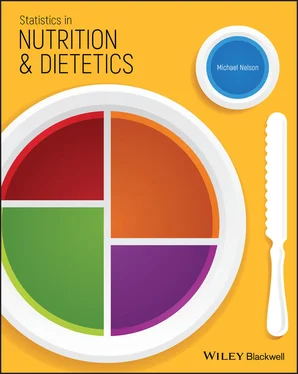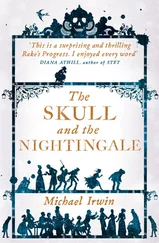Library of Congress Cataloging‐in‐Publication Data Names: Nelson, Michael (Nutritionist), author. Title: Statistics in nutrition and dietetics / Michael Nelson. Description: Hoboken, NJ : John Wiley & Sons, 2020. | Includes bibliographical references and index. Identifiers: LCCN 2019030279 (print) | ISBN 9781118930649 (paperback) | ISBN 9781118930632 (adobe pdf) | ISBN 9781118930625 (epub) Subjects: MESH: Nutritional Sciences–statistics & numerical data | Statistics as Topic | Research Design Classification: LCC RM217 (print) | LCC RM217 (ebook) | NLM QU 16.1 | DDC 613.2072/7–dc23 LC record available at https://lccn.loc.gov/2019030279LC ebook record available at https://lccn.loc.gov/2019030280
Cover Design: Laurence Parc | NimbleJack &Partners | www.nimblejack.co.ukCover Image: © filo/Getty Images; PHN Courtesy of Public Health Nutrition Research Ltd
To Stephanie

Dr. Michael Nelson is Emeritus Reader in Public Health Nutrition at King's College London, and former Director of Research and Nutrition at the Children's Food Trust. He is currently Director of Public Health Nutrition Research Ltd ( http://www.phnresearch.org.uk/).
His early career with the Medical Research Council sparked a keen interest in nutritional epidemiology, statistics, and measurement validity. Research interests have included the diets of UK school children and links between diet and poverty, cognitive function, behaviour and attainment, and monitoring the impact of standards on school lunch take-up and consumption. He collaborates nationally and internationally to promote a strong evidence base for school food policy. He has published over 200 peer-reviewed articles and other publications in the public domain.
January 2020
Preface
WHY IS THIS BOOK NEEDED?
Worldwide, there is no basic statistics textbook that provides examples relevant to nutrition and dietetics. While it could be argued that general medical science statistics texts address the needs of nutrition and dietetics students, it is clear that students find it easier to take on board the concepts relating to statistical analysis and research if the examples are drawn from their own area of study. Many books also make basic assumptions about students' backgrounds that may not always be appropriate, and use statistical jargon that can be very off‐putting for students who are coming to statistics for the first time.
The book is aimed at undergraduate and postgraduate students studying nutrition and dietetics, as well as their tutors and lecturers. In addition, there are many researchers in nutrition and dietetics who apply basic statistical techniques in the analysis of their data, for whom a basic textbook provides useful guidance, and which helps to refresh their university learning in this area with examples relevant to their own field.
The level of the material is basic . It is based on a course that I taught at King's College London over many years to nutrition and dietetics students, physiotherapists, nurses, and medical students. One of the aims was to take the fear and boredom out of statistics. I did away with exams, and assessed understanding through practical exercises and coursework.
This book takes you only to the foothills of statistical analysis. A reasonable competence with arithmetic and a little algebra are required. For the application of more demanding and complex statistical techniques, the help of a statistician will be needed. Once you have mastered the material in this book, you may want to attempt a more advanced course on statistics.
The aim of this book is to provide clear, uncomplicated explanations and examples of statistical concepts and techniques for data analysis relevant to learning and research in nutrition and dietetics. There are lots of short, practical exercises to work through. These support insight into why various tests work. There are also examples of SPSS 1 output for each test. This makes it is possible to marry up the outcomes computed manually with those produced by the computer. Examples are taken from around the globe relating to all aspects of nutrition, from biochemical experiments to public health nutrition, and from clinical and community practice in dietetics. All of this is complemented by material online, including data sets ready for analysis, so that students can begin to understand how to generate and interpret SPSS output more clearly.
The book focuses on quantitative analysis. Qualitative analysis is highly valuable, but uses different approaches to data collection, analysis, and interpretation. There is an element of overlap, for example when quantitative statistical approaches are used to assess opinion data collected using questionnaires. But the two approaches have different underlying principles regarding data collection and analysis. They complement one another, but cannot replace one another.
Two things this book is not. First, it is not a ‘cookbook’ with formulas. Learning to plug numbers in to formulas by rote does not provide insight into why and how statistical tests work. Such books are good for reminding readers of the formulas which underlie the tests, but useless at conveying the necessary understanding to analyze data properly or read the scientific literature intelligently. Second, it is not a course in SPSS or Excel. While SPSS and Excel are used to provide examples of output (with some supporting syntax for clarity), it is no substitute for a proper course in computer‐based statistical analysis.
The book provides:
a basic introduction to the scientific method
an understanding of populations and samples, principles of measurement, and confidence intervals
an understanding of the basic theory underlying basic statistical tests, including ‘parametric’ tests (those intended for use with data that follow mathematically defined distributions such as the so‐called ‘normal’ distribution); and ‘non‐parametric’ tests, for use with data distributions that are not parametric
lots of worked examples and exercises that show how to compute the relevant outcome measures for each test, both by hand and using SPSS
real examples from the nutrition and dietetics literature, including biochemical, clinical, and population‐based examples
principles of research design, transformations, the relevance of sample size, and the concept and calculation of Power
All of the exercises have worked solutions.
Some students say, ‘Why do we have to do the exercises by hand when the computer can do the same computations in a fraction of a second?’ The answer is: computers are stupid. The old adage ‘garbage in, garbage out’ means that if you don’t have insight into why certain tests work the way they do, a computer will generate output that might be meaningless, but it won’t tell you that you’ve made a mistake, or ask ‘Is this really what you wanted to do?’ So, the purpose of the textbook and supporting learning materials is to help ensure that when you do use a computer, what goes in isn’t garbage, and what comes out is correct and provides meaningful answers to your research questions that you can interpret intelligently.
Finally, it is worth saying that some students will find this textbook providing welcome explanations about why things work the way they do. Others will find it annoyingly slow and detailed, with too much explanation for concepts and applications that seem readily apparent. If you are in the first group, I hope you enjoy the care with which explanations and examples are presented and that it helps to demystify what may at first seem a difficult topic. If you are in the second group, read quickly to get to the heart of the matter, and look for other references and resources for material that you feel is better suited to what you want to achieve. However hard or easy the text seems, students in both groups should seek to make friends with a local statistician or tutor experienced in statistical analysis and not try and do it alone.
Читать дальше













